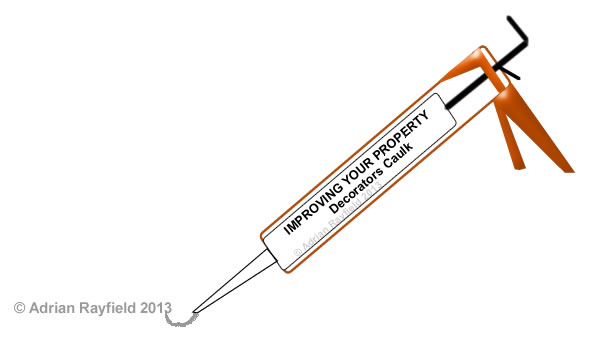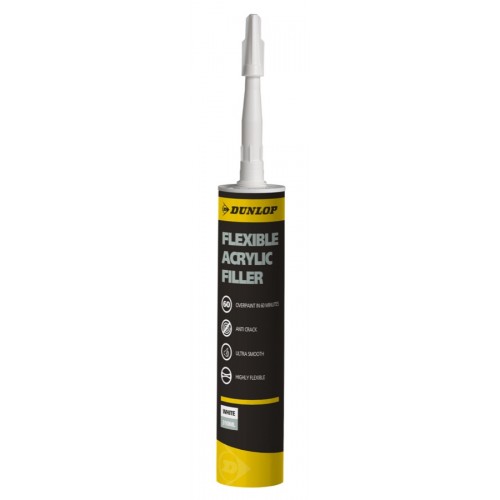Painting, decorating and home improvement tips blog
What is decorators caulk
Posted by Adrian
February 22nd, 2019
What is decorators caulk / filler
Decorators caulk is a decorating gap filler, is made of an acrylic and is flexible once dried. It is ideal for areas that have movement but cannot be used like a powder filler and cannot be rubbed down, it can be painted over. It is the best kept decorators secret ever, my wife had never heard about “flexi-filler” as she calls it until I met her.
Notice the spelling also, it is decorators caulk, not cork.
What is decorators caulk used for
Decorators caulk, or decorators filler as it’s sometimes called is used for filling gaps around door and window frames, along the top of skirting boards, gaps around the ceiling and coving line and is ideal for using if there is movement due to it’s flexible properties.

Use decorators caulk for:
- Around Door frames
- Around Window frames (Wood or UPVC)
- Skirting boards
- Ceiling and wall line
- Around coving
- Staircases
- Interior wall corners
How long does decorators caulk take to dry
This is dependent on many factors such as room temperature and humidity, size of gap filled and porousness of where it has been applied. The drying time can be anything from 20 minutes to 2 or more hours. If unsure it is best to leave for a few hours before over painting it.
How to use decorators caulk
Decorators caulk is easy to use, we have written a post detailing how to use decorators caulk on our other blog DIY By Design so there isn’t any need to cover it in depth here.
Why does decorators caulk crack
Decorators caulk may crack if the gap you filled is too large, it may also sink or shrink slightly. If this is the case apply a second layer of caulk over the top of the first one.
If the caulk has cracked or crazed when you have painted it, this could be you didn’t leave it long enough for it to dry.
It isn’t uncommon for paint to crack or craze on top of the filler, this is mostly a problem for emulsions, a simple solution is to paint over the caulk with a non-vinyl paint, such as an acrylic primer.
Update
I have done a review on a caulk that doesn’t crack or craze, I have been using it for a while and the results are good.
Read my Review Of Dunlop Pro Decor Flexible Acrylic Filler Caulk here. And if you would like to buy some for yourself you can buy Dunlop Pro Decor Flexible Filler caulk from here.

Tags: Acrylic, caulk, Caulking, Ceiling, Coving, Decorators Caulk, DIY, Door, Filler, Frame, Handyman, Skirting Boards, Window
Posted in Decorating Tips, Home Improvements | 1 Comment »
Types of wallpaper paste
Posted by Adrian
January 23rd, 2019
Types of wallpaper paste
There are many types of wallpaper paste and choosing the correct one can be confusing. Hopefully this post will help you decide the appropriate paste for the paper you are hanging.
The first place to look is on the hanging instructions themselves, this may come as a leaflet that came with the paper of a leaflet in the roll itself. If you are at all unsure ask your supplier or the wallpaper manufacturer directly.
Cold water paste
This is the type of paste that you mix yourself, you mix it with cold water. The amount of water depends on the type of paper being hung, you can find out how many litres of water to use on the paste sachet or box it comes in.
Getting it mixed correctly is the important part so it is strong enough to hold the paper. It is the easiest paste to remove as it is water soluble. This type of paste is starch based.
Here is a short video of how to mix the perfect wallpaper paste up:
All purpose
This paste is made for the majority of wallpapers from lining papers, to embossed and vinyl papers, but you should always check before using paste, especially on specialised papers.
Heavy duty
As the name suggests, this paste is for heavy duty or heavy weight papers, giving stronger adhesion than standard adhesives. It is however harder to remove when redecorating and if you get paste on the front of the paper, so care should be taken not to mark or damage the front of the paper and remove any excess paste as soon as possible.
Extra strong
This type of paste can be in the form of a powder paste or ready mixed, it is ideal for medium weight papers such as lining paper, embossed and anaglypta papers.
Paste the wall
As the name suggest, paste the wall adhesives mean you apply the paste direct to wall and not the back of the paper. This paste is only used for paste the wall papers as the paper has been designed that way and pasting the paper isn’t required.
Ready mixed
Ready mixed pastes come in tubs and are formulated and are vinyl based and do not dry out until they are exposed to air, such as when applied hung wallpaper. Some wallpapers recommend using a ready mixed paste whereas some wallpaper manufacturers may recommend their own ready mixed paste to ensure good adhesion to the surface the paper is being applied to.
The ready mixed pastes do tend to be more expensive than say cold water mixed pastes.
Wallpaper Calculator
Apart from your paste, you will need how many rolls of wallpaper, or ceiling paper to buy. We have a handy calculator for you do work out how many rolls you need to buy. Simply go to our Wallpaper calculator or Ceiling paper calculator, enter the measurements and hit the submit button, the amount of rolls you require will then be returned.
Tags: All purpose, Calculator, Ceiling, Cold Water Paste, Heavy duty, How to mix wallpaper paste, Paste, Paste the wall, Video, Wallpaper, Wallpapering
Posted in Decorating Tips, Home Improvements | No Comments »
What you will find under your wallpaper
Posted by Adrian
April 27th, 2018
what you will find under your wallpaper
When removing wallpaper, you never know what you might find underneath. This is typically true of older houses but can also apply to newer houses.
I’ll use one of my jobs as a case study. The job was a spare bedroom, a simple remove old wallpaper, paint the ceiling and woodwork and then re-paper, but like the title of this post says, you never know ‘what you will find under your wallpaper’.
Removing Wallpaper
I removed the wallpaper top layer and soaked the under layer, all was going well and as expected. Then I removed the paper around the windows. These were not original windows and had been renewed with uPVC windows.
It was here that I found the broken away plasted that had left a deep hole. I have come across this problem many times so wasn’t surprised.
Luckily I always carry a fast setting filler so I could fill the deep hole to just below the surface, and finish of with a fine filler. This was done within half a day so I wasn’t help up, I then waited until the next day to hang the wallpaper and could complete the work on time at no extra cost.
As you never know what you may find under the old wallpaper, it is best to expect the unexpected, sometimes it maybe just lots of holes, other times it may involve blown plaster or loose render and plaster around replaced windows and doors.
You may be lucky and only find the dates of when the room was decorated over the years written on the wall, don’t forget to add yours!







Tags: bedroom, Ceiling, Door, Filler, Holes, Paint, Plaster, Removing Wallpaper, Render, replacement windows and doors, UPVC, Wallpaper, Walls, Window, Woodwork
Posted in Decorating Tips | No Comments »
